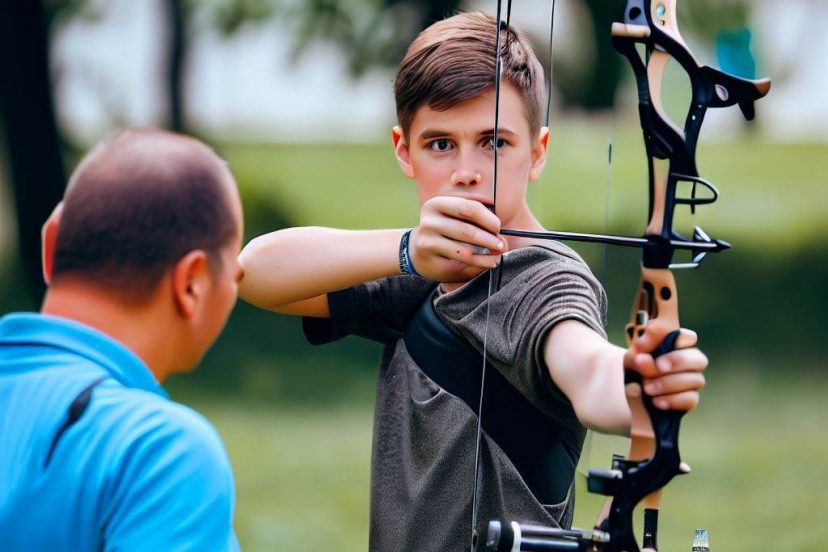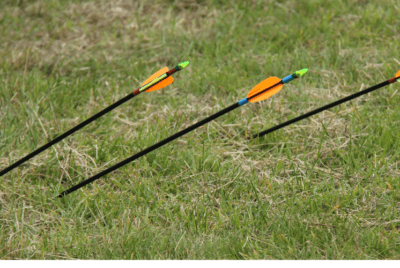Archery for Beginners: Mastering the Art of Shooting Arrows
Introduction
Are you ready to embark on an exciting journey into the world of archery? Whether you’ve been captivated by the grace of archers in movies or have a personal fascination with this ancient sport, this comprehensive archery for beginners guide is here to support you as you take your first steps as an archery enthusiast. In this article, we’ll cover all the essential knowledge and practical tips you need to kickstart your archery journey with confidence.
From understanding the basic equipment to mastering proper form and technique, we’ll guide you through the fundamentals of archery for beginners. We’ll explore the building blocks of a solid foundation, including exercises to enhance strength and coordination. Additionally, we’ll delve into the various styles of archery, allowing you to discover the paths that resonate with your interests and aspirations.
But archery isn’t just about shooting arrows at a target—it offers a plethora of benefits beyond the sport itself. We’ll uncover the physical and mental rewards that come with practicing archery, such as improved fitness, enhanced focus, and a deeper connection with nature. Furthermore, we’ll highlight the social engagement and personal growth opportunities that await you in the vibrant archery community.
So, if you’re ready to unleash your inner archer, let’s dive into this archery for beginners guide. Whether you dream of shooting arrows like your favourite hero or simply seek a fulfilling hobby, this guide will provide you with the knowledge and inspiration to begin your archery adventure. Let’s string our bows, take aim, and let the arrows fly!
Archery for Beginners : Understanding the Basics
Before diving into the technical aspects, let’s start by understanding the fundamental components of archery:
The Bow
The bow is the core equipment in archery. There are various types of bows, including recurve bows, compound bows, longbows, and traditional bows. As a beginner, it’s recommended to start with a recurve bow, which offers simplicity, versatility, and ease of use.
Arrows
Arrows are carefully designed projectiles that vary in length, material, and weight. They consist of a shaft, fletching (feathers or vanes), a nock, and a point. It’s crucial to select arrows that match your bow’s draw weight and your shooting style.
Protective Gear
Safety should always be a priority in archery. Invest in essential protective gear, including an arm guard, finger tab or glove, and an archery-specific bracer. These items protect your forearm, fingers, and wrist from potential injuries caused by the bowstring.
The Range
Finding a suitable archery range is essential for practicing and honing your skills. Look for a local archery club or range that provides a safe and supportive environment. These places often offer equipment rentals, beginner-friendly courses, and experienced coaches to guide you along your archery journey.

Mastering Archery Form and Technique
Proper form and technique are the foundation of accurate and consistent shooting. Let’s explore the key elements:
Stance and Posture
Maintaining a solid stance and posture is crucial for stability and balance. Stand perpendicular to the target, with your feet shoulder-width apart. Distribute your weight evenly and keep your body relaxed. Align your body with the target and slightly lean forward to engage your core muscles.
Hand Placement and Grip
Gripping the bow correctly is vital for consistent shooting. Hold the bow’s grip firmly but without excessive tension. Your knuckles should be at a 45-degree angle to the bow, and your fingers should wrap around the grip naturally. Avoid gripping too tightly, as it can introduce torque and negatively impact your shot.
Nocking and Drawing the Bowstring
Nocking the arrow refers to placing it correctly on the bowstring. Ensure that the index vane or feather is facing away from the bow and securely seated on the arrow rest. When drawing the bowstring, maintain a smooth and controlled motion, focusing on a consistent anchor point. This anchor point, such as the corner of your mouth or the chin, should be the same for each shot.
Aiming and Sight Picture
Aiming is a crucial aspect of archery. As a beginner archer, start with a basic aiming technique called “sight picture.” Align the tip of the arrow, the bow sight, and the target, while keeping your focus on the target. With practice, you will develop a sense of instinctive aiming, relying on muscle memory and visual perception to hit the target consistently.
Release and Follow-Through
Releasing the bowstring smoothly and consistently is key to accuracy. Avoid “punching” the release, which refers to a jerky and sudden release of the bowstring. Instead, focus on a controlled and relaxed release, allowing the energy of the bow to propel the arrow forward. After the release, maintain your follow-through by keeping your bow arm extended and your body balanced. This ensures a clean release and prevents any unnecessary movement that could affect the flight of the arrow.
Building a Solid Foundation
To establish a solid foundation in archery, there are essential steps and practices that every beginner should follow:
Start with Basic Exercises
Begin your archery journey by practicing basic exercises to develop strength, coordination, and muscle memory. These exercises can include drawing the bow without an arrow, working on your stance, and performing stretching and warm-up routines. Gradually increase the difficulty and intensity of these exercises as you build strength and confidence.
Seek Professional Guidance
Enrolling in archery classes or seeking guidance from a certified instructor is highly recommended. An experienced instructor can provide personalized feedback, correct any form errors, and guide you through the learning process. They can also introduce you to structured training programs tailored to your skill level and goals.
Consistent Practice
Consistency is key to improving your archery skills. Set aside dedicated practice sessions and aim to practice regularly, ideally a few times a week. Short but focused practice sessions are often more effective than sporadic longer sessions. Remember to prioritize quality over quantity, paying attention to your form and technique with each shot.
Gradually Increase Distance
As you become more comfortable and confident with your shooting, gradually increase the shooting distance. Start at a close range, such as 10 yards, and progressively move back as you improve. This gradual progression allows you to refine your form and accuracy without feeling overwhelmed.
Document Your Progress
Keeping a record of your progress can be highly motivating and insightful. Create a journal or logbook to track your shooting sessions, noting the distance, scores, and any observations. This helps identify patterns, areas for improvement, and serves as a reminder of how far you’ve come on your archery journey.
Exploring Archery Styles and Opportunities
Archery offers a diverse range of styles and opportunities to explore. Here are some avenues to broaden your archery experience:
Traditional Archery
Traditional archery embraces the historical roots of the sport and involves shooting with traditional bows, such as longbows or recurve bows without the use of modern accessories like sights or stabilizers. It provides a deeper connection to archery’s heritage and allows for a more instinctive and intuitive shooting style.
Target Archery
Target archery is a popular discipline that involves shooting at standardized targets from set distances. It is often practiced in a controlled environment, such as an archery range or indoor facility. Target archery allows you to refine your technique, focus on accuracy, and participate in competitions at local, national, and international levels.

Field Archery
Field archery takes place in a natural, outdoor setting, simulating hunting scenarios. It involves shooting at targets placed at various distances and angles, often in wooded or uneven terrains. Field archery challenges your adaptability, judgment, and ability to adjust for different shooting conditions.
Bowhunting
Bowhunting combines archery skills with the pursuit of game animals. It requires patience, stealth, and a deep understanding of animal behavior. Bowhunting offers a unique connection with nature and allows you to experience the thrill of harvesting your own food ethically and respectfully.
Archery Competitions
Competing in archery competitions can be a rewarding experience that pushes your skills to new heights. Whether it’s local club competitions, regional tournaments, or national championships, participating in archery competitions provides opportunities to test your abilities, set goals, and measure your progress against other archers.
The Benefits of Archery
Engaging in archery as a beginner offers numerous benefits that extend beyond the technical aspects of the sport. Here are some of the rewards you can expect:
Physical Fitness and Coordination
Archery is a physically demanding activity that engages various muscle groups, including your back, shoulders, arms, and core. Drawing the bow and holding it steady require strength and stamina. Regular practice improves your posture, stability, and overall fitness level. Additionally, archery enhances hand-eye coordination, fine motor skills, and proprioception—the ability to sense and control body movements.
Mental Focus and Relaxation
Archery requires mental focus, concentration, and mindfulness. The act of shooting requires you to block out distractions, calm your mind, and enter a state of flow. This meditative aspect of archery can promote relaxation, reduce stress, and improve mental clarity. It offers a unique opportunity to disconnect from the daily hustle and find inner calm.
Discipline and Patience
Archery is a sport that demands discipline and patience. To excel, you must commit to regular practice, embrace the process of skill development, and remain patient as you work towards achieving your goals. Archery teaches valuable life skills such as perseverance, self-discipline, and the ability to handle setbacks with grace.
Connection with Nature
Archery often takes place in outdoor settings, connecting you with the natural world. Whether shooting in a forest, on a field, or in the mountains, archery allows you to immerse yourself in the beauty of nature. It provides a sense of tranquillity and appreciation for the environment, fostering a deeper connection with the outdoors.

Social Engagement and Community
Archery offers opportunities for social engagement and building connections with like-minded individuals. Joining archery clubs or participating in group activities allows you to meet fellow archers, share experiences, and exchange knowledge. The archery community is welcoming and supportive, providing a sense of camaraderie and friendship.
Personal Growth and Achievement
As you progress in archery, you will experience personal growth and a sense of achievement. Each milestone reached, whether it’s improving your accuracy, competing in your first tournament, or mastering a new shooting technique, brings a sense of accomplishment. Archery challenges you to step out of your comfort zone, overcome obstacles, and discover your own potential.
Conclusion
Embarking on the journey of archery as a beginner is an exciting and rewarding endeavor. By understanding the basics, focusing on proper form and technique, and committing to consistent practice, you can develop the skills and knowledge necessary to excel in this ancient sport. Remember to embrace the mental aspect of archery, explore different styles and opportunities, and enjoy the personal growth and benefits that archery brings.
If you have any further questions or need guidance along the way, don’t hesitate to seek assistance from experienced archers, coaches, or archery communities. Embrace the challenge, stay persistent, and let the arrows fly true on your archery journey!
FAQs (Frequently Asked Questions)
Q1: How long does it take to become proficient in archery?
Becoming proficient in archery depends on various factors such as practice frequency, individual aptitude, and goals. With dedicated practice, beginners can develop a solid foundation within a few months. However, mastery and continuous improvement are lifelong pursuits.
Q2: Is archery safe for children?
Archery can be safe for children when proper safety measures are in place and adult supervision is provided. It’s important to choose age-appropriate equipment, ensure a controlled shooting environment, and emphasize proper technique and safety rules.
Q3: Can I participate in archery if I have a physical disability?
Absolutely! Archery is an inclusive sport that can be adapted to accommodate various physical abilities. Many archery organizations offer adapted equipment and divisions for individuals with physical disabilities. With the right support and modifications, archery can be enjoyed by people of all abilities.
Q4: How do I choose the right bow and arrows?
Choosing the right bow and arrows depends on factors such as your physical strength, shooting style, and intended use. It’s recommended to visit a reputable archery shop or consult with knowledgeable archery professionals who can assess your needs and provide personalized recommendations based on your specific requirements.
Q5: Are there any age restrictions for participating in archery?
There are no specific age restrictions for participating in archery. Archery can be enjoyed by individuals of all ages, from young children to seniors. However, it’s important to consider the physical capabilities and maturity level of young children and provide appropriate supervision and guidance.
Q6: Can I practice archery indoors?
Yes, archery can be practiced indoors, provided that you have a suitable space with a sufficient shooting distance and a proper backstop or target containment system. Many archery ranges and facilities offer indoor shooting options, allowing archers to practice year-round regardless of weather conditions.
Q7: How do I care for my archery equipment?
Taking care of your archery equipment is essential for its longevity and optimal performance. Regularly inspect your bow and arrows for any signs of damage or wear. Store your equipment in a cool, dry place and protect it from extreme temperatures and humidity. Keep your bowstring clean and well-maintained, and regularly wax it to prevent fraying. It’s also a good practice to periodically check and tighten any screws or fasteners on your bow.
Q8: Can I hunt with a recurve bow or a compound bow?
Yes, both recurve bows and compound bows can be used for hunting. However, it’s important to familiarize yourself with local hunting regulations and laws. Additionally, hunting requires additional skills and knowledge, such as understanding animal behavior, tracking, and shot placement. It’s recommended to seek guidance from experienced hunters and to participate in hunter education programs to ensure a safe and ethical hunting experience.
Remember, archery is not just a sport—it’s a journey of personal growth, discipline, and connection with both yourself and the natural world. Enjoy the process, be patient with yourself, and savor every arrow that soars towards the target. Happy shooting!






Comments are closed.